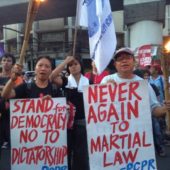Edwin Vergara, 43, owns a small hut in Maria Paz village in Tanauan. He resides there with his wife and four children.
Edwin relies primarily on livestock for a living, and plants vegetables on their backyard for added income. He would sell his produce at the market. His wife helps out by working in a bakery.
As Taal volcano began to cover their village with mud and ash on Jan. 12, Edwin sent his family away to join hundreds leaving for safety. He stayed behind to look after their house and livestock, with many other fathers.
“Taal volcano’s eruption is the worst calamity I have experienced so far,” Edwin recalled. “I felt helpless when I saw our house being covered in volcanic dust and debris. I immediately thought we were going to loss our home.”
Maria Paz is a coastal village located on Tanauan’s shoreline that protrudes into Taal lake. The place sits 7 kilometers northeast of the volcano’s crater.
When the volcano erupted, the villagers knew a debilitating halt befell their village.
Edwin’s family reunited with him in their Tanauan home after two weeks, even as the volcano spewed ash and the ground shook. They returned to a home that had accumulated ash fall, the roof partially damaged by the weight. Some livestock also withered.
Edwin’s household was among the 430 families that received relief aid from Iglesia Filipina Independiente’s Kapit-Bisig initiative on Feb. 17 at the Maria Paz village covered court.
He meekly, patiently waited in line. He then quickly darted home after receiving his share, food to last the family two weeks.
Soon after, he returned carrying along a bunch of ripe bananas. He gave the bananas, which came from his own backyard, to the priest-coordinator of the relief operations in Batangas province, Rev. Cesar Hilario.
After a brief conversation with the priest, he headed home once more. But, before departing, he again uttered his gratitude for the gifts his family received from Kapit-Bisig. Rev. Hilario said his heart almost melted with Edwin’s kind gesture.
“I have helped handing relief goods to about 2,000 people since we started the Kapit-Bisig relief operations, and this is the first time someone came back and gave us something in return,” he said. “Edwin is someone who lost almost everything but was still able to share a part of what was left of him. He gave us a gift even if his family was amid scarcity and uncertainty. I am greatly blessed by this encounter.”
In their brief conversation, Edwin told Rev. Hilario of his fear that his family might lose their little hut and backyard. It’s not the ashfall and mud that alarms them this time around. It’s the threat of a government mandate declaring several towns and villages within Taal volcano’s danger zone as “no man’s land.”
“I can’t say I worried during the eruption as much as I worry now about the government’s plan to place our village under permanent lockdown. We don’t want to loss our home,” Edwin said.
If the government pursues its plan, hundreds of poor families like Edwin’s — most of whom depend on the rich waters of Taal Lake and the fertile soil around the volcano for a living — stand to loss not only their livelihood.
They will also leave behind the mother they have loved and called by her sweet name, “Mary of Peace,” their village home Maria Paz.


